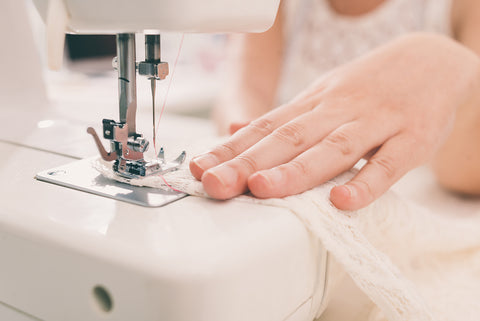The Different Types of Industrial Sewing Machines: Stitch Types
Posted by Joseph Park on

Industrial and domestic sewing machines have a lot of things in common, but if there were one thing that stands out as a main differentiator between these two basic types of sewing machines, it would be the specialization aspect.
Domestic sewing machines typically perform a variety of stitch types and patterns. Industrial sewing machines, on the other hand, come in various models, each of which performs a specific function. Thus, it’s normal for a garment manufacturing facility to own a machine that only does lockstitches, for example, or a machine that only sews buttons. This facility is likely to have many other specialized machines.
This diversity in industrial sewing machines comes as a result of the pursuit for quality. Specialized sewing machines tend to create stitches and patterns that are more refined and are of better quality than those created by home sewing machines.
Performance is another important distinction between domestic and industrial sewing machines. Because the motors of industrial variants are significantly larger and more robust than those of domestic units, they can also run for much longer. The motors of industrial sewing machines are usually so large that they are placed beneath the tables upon which the machines rest. In contrast, domestic sewing machines come with motors attached to their bodies.
As quality and performance are the selling points of industrial sewing machines, businesses are usually willing to shell out a good amount of resources just to have a complete set of the machines they need. When it comes to acquiring machines that perform different stitches, they usually have these four basic types of industrial sewing machines to choose from:
Lockstitch sewing machines – Lockstitch sewing machines produce lockstitches, which are created when the upper thread (from the spool on the top spindle) and the lower thread (from the bobbin) interlock or twist together as they pass through the hole created by the needle. The stitches on top of the fabric appear the same as those on the bottom.
One variant of the lockstitch sewing machine is the zigzag stitch sewing machine, which creates zigzag stitches instead of straight ones. Zigzag-patterned stitches can be very useful for edging fabrics or for overcasting buttonholes, as well as for stitching stretchy fabrics.
Overlock sewing machines – Overlock sewing machines or sergers are used to make overlock stitches, which are a series of thread loops that are usually sewn over the edge of the fabrics. Overlock stitches can also be used for hemming and seaming.
An overlock sewing machine typically cuts the edge of the fabric as it is being stitched. This is helpful because the user will no longer have to cut these frayed or uneven edges.
Chainstitch sewing machines – A chainstitch is formed when the thread is sent by needle down the fabric and interloops with itself, thus forming a “chain.” Most chainstitch sewing machines produce chainstitches with just one thread, while others create them with two threads.
Coverstitch sewing machines – Coverstitch sewing machines are widely used in the sewing industry. On the top side of the fabric, their twin needles produce parallel rows of straight stitches. On the back side, their loopers produce overlock or serge stitches. Coverstitches are very popular in garment construction. Check your shirts at home, and you’ll find out that most of them, if not all, are hemmed with coverstitches.
Take note that although there are dozens of stitch types recognized by institutions like the International Organization for Standardization (ISO) and by the American Society for Testing and Materials (ASTM), these are usually just variations of these four common types of stitches.
In future articles, we will also be giving short overviews about the different types of industrial sewing machines based on their body designs and on their feed mechanisms.
Share this post
- Tags: chainstitch sewing machines, domestic sewing machines, industrial sewing machines, lockstitch sewing machines, overlock sewing machines, overstitch sewing machines, sewing machines, stitch types
